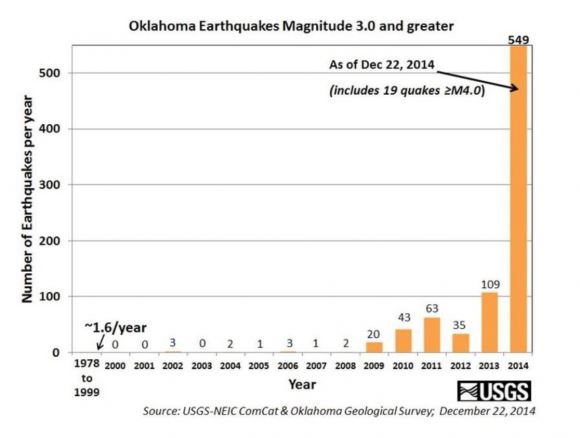Does Fracking Cause Earthquakes? No. Windmills Do.
Hold on there! I wouldn’t be so quick to blame fracking. In every place where earthquakes are on the rise, we see an increase in the construction of windmills.
Take, for example, this story by the Enid News about earthquakes in Oklahoma. It cites a U.S. Geological Survey that reports over 549 earthquakes greater than 3.0 magnitude in 2014. This is a drastic rise compared to 2013, when there were 109, and in 2012 when there were 39. This large, sudden rise demands we investigate windmills.

Instead, according to the Enid News, the USGS is investigating if injection wells associated with fracking are responsible for earthquakes.
What are injection wells? You may not be aware of this because I wasn’t until I began working in the oilfield, but oil wells actually produce more water than oil. The oil from a well goes to the refinery, but the produced water is pumped back deep underground at a place called an injection well.
The culpability of injection wells (and therefore fracking) comes into doubt when you consider two facts. First, the distribution of earthquakes does not correlate to the distribution of water injection wells. And second, the sudden rise in earthquakes did not begin until 2009.
Can we blame windmills?
The construction of windmill farms in Oklahoma correlates much better to the sudden upward trend of earthquakes. Remember the key year is 2009. That was long after fracking had already achieved widespread implementation. But it was just on the cusp of a massive uptick in windmill farm construction.
But then in 2009, things took a turn for the worse. Large truck convoys pulling loads too big for residential roads clogged Sooner state highways. Eerie metal monstrosities appeared everywhere on the horizon. Their looming stature, lethargic rotating, and sub-sonic droning caused unsettling feeling in people living nearby. Soon livestock were birthing defective offspring. Rumors swirled that the magnetic fields of these windmills next to the ranch were to blame.
The wind applies force to the windmills. Enough force to generate 1128 megawatts. But do the windmills fall over when the wind blows on them? No. So that means that even though some of the wind energy is turned into electrical energy, something else is applying enough force in the opposite direction of the wind to keep the windmills erect. What is that thing? I’ll give you a clue. It’s what the windmills are anchored into: the ground.
The windmill boom where it literally booms
Remember that 2009 was the year when the windmill building boom just took off. (Together with magnitude 3.0 earthquakes.) In the several years after, Oklahoma kept building many more farms. In 2012 alone, they built 10. One of those, the Canadian Hills Wind Farm, keeps 135 turbines in operation with a total capacity of 295 MW. By the end of 2012, there were 26 wind farms online with a projected capacity of 3.175 Gigawatts.
If we take the USGS chart of the magnitude 3.0 earthquakes in Oklahoma, and add to it the collective capacity of windfarms by year, we see a trend that shows a proportional correlation.

The time for action is now! Windmills cause earthquakes.
References
http://feedingjimmy.com/fracking-cause-earthquakes-windmills/